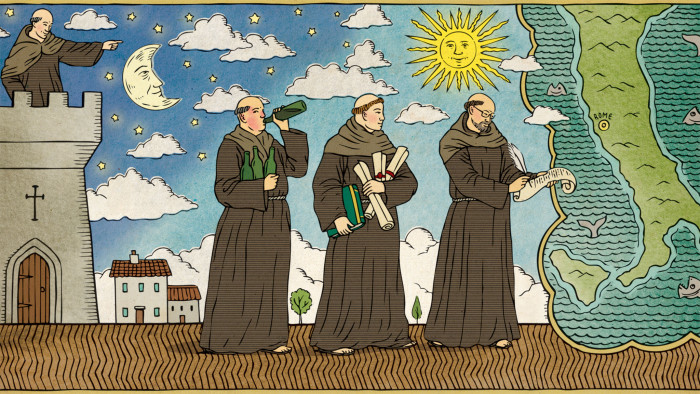‘John the Pupil’, by David Flusfeder

Simply sign up to the Life & Arts myFT Digest -- delivered directly to your inbox.
The English philosopher and Franciscan friar Roger Bacon (c1214-c1292) was believed by the Victorians to be a forerunner of the modern scientific method. It was thought that, inspired by Aristotle, he questioned everything – especially the philosophical methods of the Parisian schoolmen such as Thomas Aquinas. Thanks to Bacon’s open-mindedness, he was able to pioneer such technological innovations as spectacles and gunpowder. It would even seem that, centuries before Leonardo da Vinci, he had pioneered a proto-flying machine. He also apparently worked out why the Julian Calendar was askew, and it is thought that he wrote to the Pope, Clement IV, explaining how the adjustment could be made – an adjustment for which the world actually waited until Gregory XIII altered the calendar in October 1582.
Modern scholars tend to think that Bacon’s status as a fearless enlightened scientist born out of time was much exaggerated by the Victorians; that he in fact got most of his theories from other medieval books, rather than through scientific research. True, he was very widely read in Arabic and Greek – rare accomplishments in 13th-century England. But a Victorian agnostic he was not.
It is the admittedly more exciting Victorian idea about Bacon that inspires American author David Flusfeder’s new historical novel, John the Pupil. As he tells it, Bacon’s fellow-Franciscan monks in Oxford suspect Friar Bacon of heresy, and are deeply suspicious of what goes on while he is up in his tower conducting his experiments. Bacon therefore hoodwinks them. He allows his young amanuensis, John, to be caught stealing wine from the cellar; and as a penance John has to go to Rome to pray for the forgiveness of the Pope. Just what Bacon wanted, for this will give John, and two young companions from the friary, Brother Bernard the drunk and Brother Andrew, the opportunity to take Bacon’s great scientific book, his lenses and his flying machine to Viterbo – where Pope Clement IV is in exile. (In real life Bacon knew the Pope personally and did send him some version of his work, known as the Opus Majus.)
The novel takes the form of John the Pupil’s travel diary, in which he records their adventures. Along the way, the trio are waylaid by thieves – above all a devious professional pilgrim called Simeon the Palmer. They are suspected in Paris of being thieves themselves. In French villages they are believed to be possessed by, or actually to be, demons. In the Alps they are seduced by a beautiful heretic, part Joan of Arc, part Heidi, who believes in free love. Every now and then Brother Bernard, who is alcoholic, goes off on a bender, leading to some good Falstaffian tavern scenes.
As they come down into Italy, they are taken captive by Cavalcante de Cavalcanti, Dante’s rich patrons. John for a time becomes a tutor to Dante’s friend, the poet Guido Cavalcanti, noting (as Dante did) that the family are all Epicureans, sensualists who did not believe in the survival of the soul beyond bodily death.
Finally, after all these adventures, John the Pupil reaches Viterbo and is admitted to the presence of the coughing, dying Clement IV. John demonstrates to him the properties of the lens, tells him about the possibility of the flying machines and . . . well, there is a twist, which I won’t spoil for you.
There are so many mishaps along the way, and so many brigands and thieves intent on grabbing John’s precious scientific belongings that I was not sure I believed he would be able to keep so much of it intact until the end of the journey. Almost every encounter leads the three companions into yet another scrape.
Flusfeder paints some plausible pictures of the Middle Ages – the crowds shuffling towards the shrine of Becket in Canterbury Cathedral, the bloody street of the butchers in Paris, the smells and the colours. The somewhat haphazard and piecemeal nature of the narrative is, we learn, intentional: it is in fact a long-lost translation (with explanatory notes) of a botched transcription of the originals, made by a Victorian amateur scholar and subsequently kept in a warehouse in Ealing, before purchase by a private collector.
It is certainly a lively tale and will appeal to anyone who is a fan of Umberto Eco’s The Name of the Rose (1980), though John the Pupil is much simpler and less dense. Eco’s book, while purporting to be a medieval story, is really a witty take on the semiotics craze of the 1970s; this novel is a more modest, old-fashioned evocation of the past. The journey is dated from one saint’s day to the next, and the story is interrupted by legendary accounts of the saints’ deeds and sayings.
Sometimes, these digressions seem a bit clumsy. This reader at least found there were too many saints’ legends and too many prayers cluttering up what is in effect a very short book.
John the Pupil, by David Flusfeder, Fourth Estate, RRP£14.99, 240 pages
AN Wilson is author of ‘The Potter’s Hand’ (Atlantic)
Illustration by Dan Mitchell
Comments